DD310: Applying Psychological Theories to Amy's Case Study Analysis
VerifiedAdded on 2023/04/20
|10
|2725
|309
Case Study
AI Summary
This paper provides a psychological analysis of a case study involving Amy, a 15-year-old female exhibiting aggressive and risk-oriented behaviors. The analysis explores potential causes, including genetic, physical, and environmental factors, with a focus on the impact of her family environment and history of domestic violence. The paper identifies oppositional defiant disorder, conduct disorder, and possible ADHD as contributing factors. It also discusses factors maintaining Amy's problems, such as strained parental relationships and negative peer influences. The paper recommends cognitive and behavioral therapies, along with systemic interventions involving family counseling, to facilitate positive change. The goal is to address Amy's behavioral issues, improve her anger management skills, and foster a healthier family environment. The paper concludes that Amy's behavior is significantly influenced by environmental and genetic factors, emphasizing the need for comprehensive interventions to support her well-being.
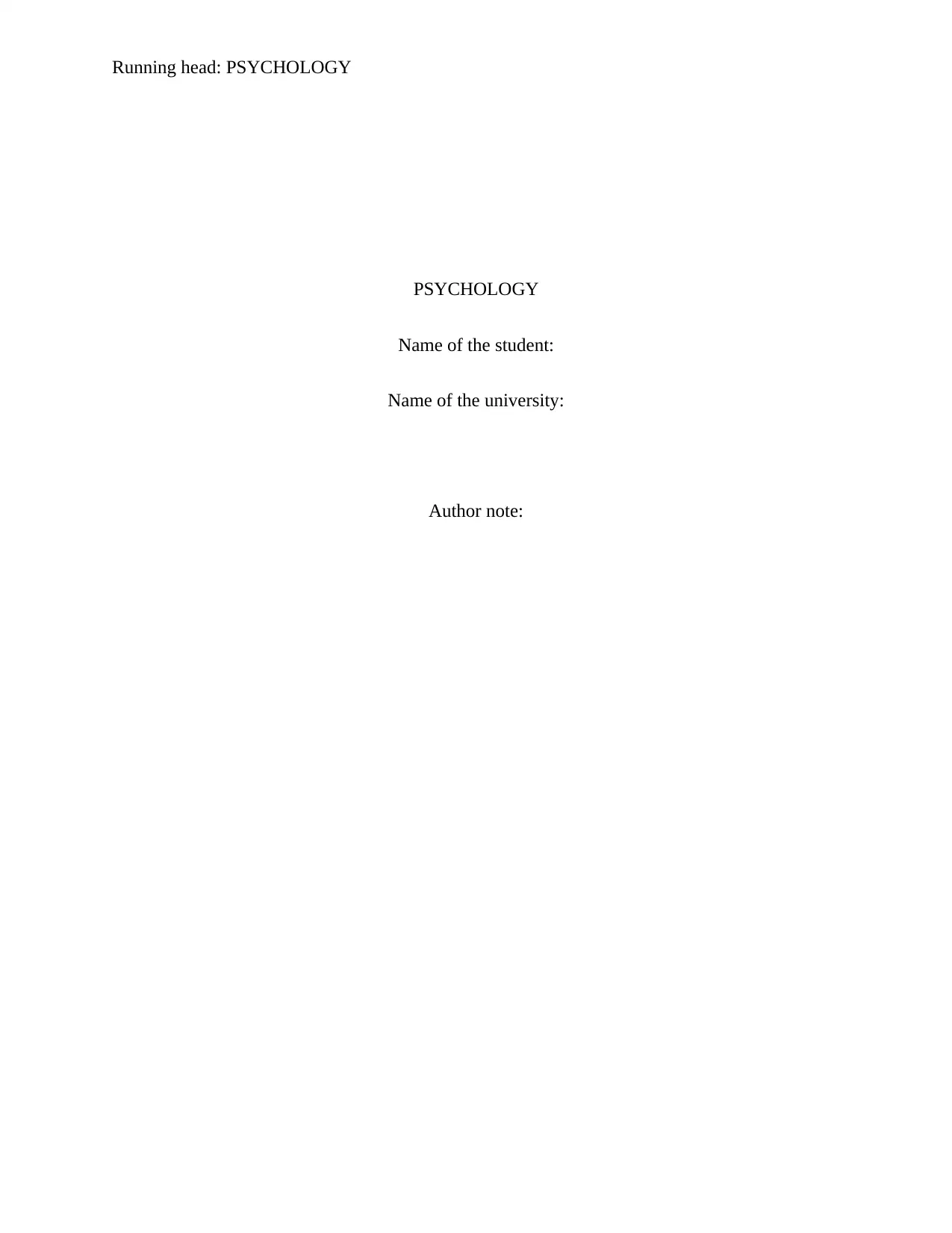
Running head: PSYCHOLOGY
PSYCHOLOGY
Name of the student:
Name of the university:
Author note:
PSYCHOLOGY
Name of the student:
Name of the university:
Author note:
Paraphrase This Document
Need a fresh take? Get an instant paraphrase of this document with our AI Paraphraser
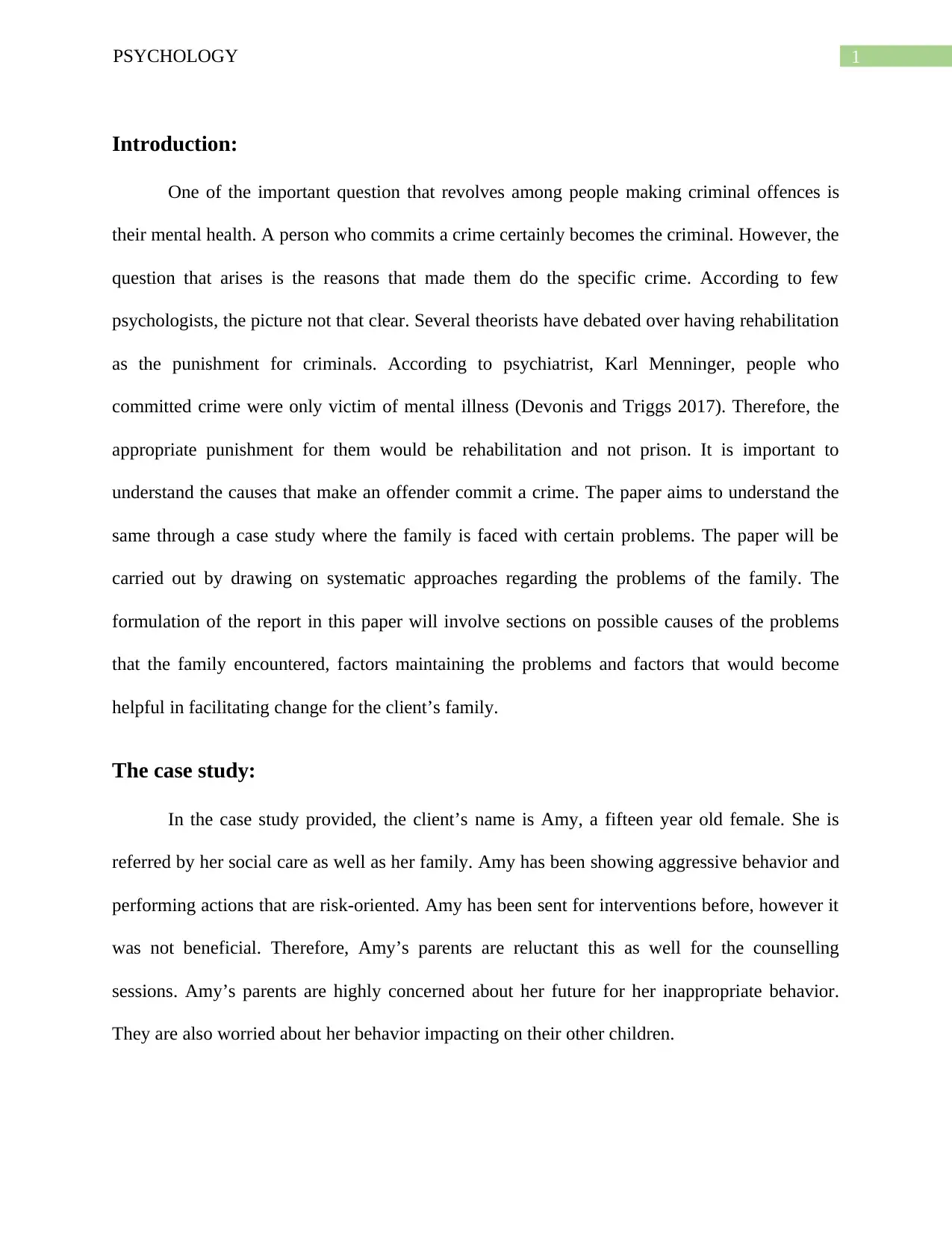
1PSYCHOLOGY
Introduction:
One of the important question that revolves among people making criminal offences is
their mental health. A person who commits a crime certainly becomes the criminal. However, the
question that arises is the reasons that made them do the specific crime. According to few
psychologists, the picture not that clear. Several theorists have debated over having rehabilitation
as the punishment for criminals. According to psychiatrist, Karl Menninger, people who
committed crime were only victim of mental illness (Devonis and Triggs 2017). Therefore, the
appropriate punishment for them would be rehabilitation and not prison. It is important to
understand the causes that make an offender commit a crime. The paper aims to understand the
same through a case study where the family is faced with certain problems. The paper will be
carried out by drawing on systematic approaches regarding the problems of the family. The
formulation of the report in this paper will involve sections on possible causes of the problems
that the family encountered, factors maintaining the problems and factors that would become
helpful in facilitating change for the client’s family.
The case study:
In the case study provided, the client’s name is Amy, a fifteen year old female. She is
referred by her social care as well as her family. Amy has been showing aggressive behavior and
performing actions that are risk-oriented. Amy has been sent for interventions before, however it
was not beneficial. Therefore, Amy’s parents are reluctant this as well for the counselling
sessions. Amy’s parents are highly concerned about her future for her inappropriate behavior.
They are also worried about her behavior impacting on their other children.
Introduction:
One of the important question that revolves among people making criminal offences is
their mental health. A person who commits a crime certainly becomes the criminal. However, the
question that arises is the reasons that made them do the specific crime. According to few
psychologists, the picture not that clear. Several theorists have debated over having rehabilitation
as the punishment for criminals. According to psychiatrist, Karl Menninger, people who
committed crime were only victim of mental illness (Devonis and Triggs 2017). Therefore, the
appropriate punishment for them would be rehabilitation and not prison. It is important to
understand the causes that make an offender commit a crime. The paper aims to understand the
same through a case study where the family is faced with certain problems. The paper will be
carried out by drawing on systematic approaches regarding the problems of the family. The
formulation of the report in this paper will involve sections on possible causes of the problems
that the family encountered, factors maintaining the problems and factors that would become
helpful in facilitating change for the client’s family.
The case study:
In the case study provided, the client’s name is Amy, a fifteen year old female. She is
referred by her social care as well as her family. Amy has been showing aggressive behavior and
performing actions that are risk-oriented. Amy has been sent for interventions before, however it
was not beneficial. Therefore, Amy’s parents are reluctant this as well for the counselling
sessions. Amy’s parents are highly concerned about her future for her inappropriate behavior.
They are also worried about her behavior impacting on their other children.
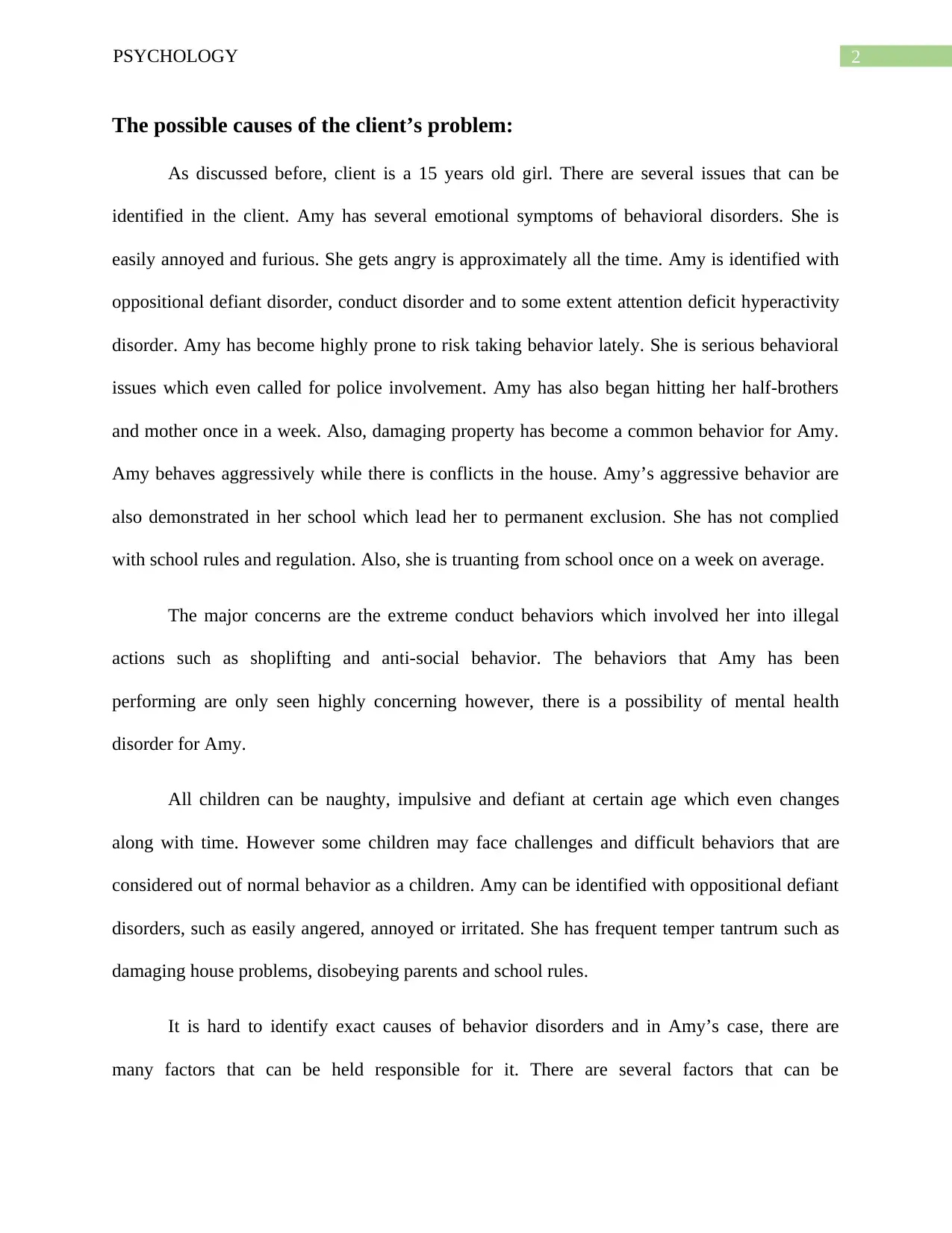
2PSYCHOLOGY
The possible causes of the client’s problem:
As discussed before, client is a 15 years old girl. There are several issues that can be
identified in the client. Amy has several emotional symptoms of behavioral disorders. She is
easily annoyed and furious. She gets angry is approximately all the time. Amy is identified with
oppositional defiant disorder, conduct disorder and to some extent attention deficit hyperactivity
disorder. Amy has become highly prone to risk taking behavior lately. She is serious behavioral
issues which even called for police involvement. Amy has also began hitting her half-brothers
and mother once in a week. Also, damaging property has become a common behavior for Amy.
Amy behaves aggressively while there is conflicts in the house. Amy’s aggressive behavior are
also demonstrated in her school which lead her to permanent exclusion. She has not complied
with school rules and regulation. Also, she is truanting from school once on a week on average.
The major concerns are the extreme conduct behaviors which involved her into illegal
actions such as shoplifting and anti-social behavior. The behaviors that Amy has been
performing are only seen highly concerning however, there is a possibility of mental health
disorder for Amy.
All children can be naughty, impulsive and defiant at certain age which even changes
along with time. However some children may face challenges and difficult behaviors that are
considered out of normal behavior as a children. Amy can be identified with oppositional defiant
disorders, such as easily angered, annoyed or irritated. She has frequent temper tantrum such as
damaging house problems, disobeying parents and school rules.
It is hard to identify exact causes of behavior disorders and in Amy’s case, there are
many factors that can be held responsible for it. There are several factors that can be
The possible causes of the client’s problem:
As discussed before, client is a 15 years old girl. There are several issues that can be
identified in the client. Amy has several emotional symptoms of behavioral disorders. She is
easily annoyed and furious. She gets angry is approximately all the time. Amy is identified with
oppositional defiant disorder, conduct disorder and to some extent attention deficit hyperactivity
disorder. Amy has become highly prone to risk taking behavior lately. She is serious behavioral
issues which even called for police involvement. Amy has also began hitting her half-brothers
and mother once in a week. Also, damaging property has become a common behavior for Amy.
Amy behaves aggressively while there is conflicts in the house. Amy’s aggressive behavior are
also demonstrated in her school which lead her to permanent exclusion. She has not complied
with school rules and regulation. Also, she is truanting from school once on a week on average.
The major concerns are the extreme conduct behaviors which involved her into illegal
actions such as shoplifting and anti-social behavior. The behaviors that Amy has been
performing are only seen highly concerning however, there is a possibility of mental health
disorder for Amy.
All children can be naughty, impulsive and defiant at certain age which even changes
along with time. However some children may face challenges and difficult behaviors that are
considered out of normal behavior as a children. Amy can be identified with oppositional defiant
disorders, such as easily angered, annoyed or irritated. She has frequent temper tantrum such as
damaging house problems, disobeying parents and school rules.
It is hard to identify exact causes of behavior disorders and in Amy’s case, there are
many factors that can be held responsible for it. There are several factors that can be
⊘ This is a preview!⊘
Do you want full access?
Subscribe today to unlock all pages.

Trusted by 1+ million students worldwide
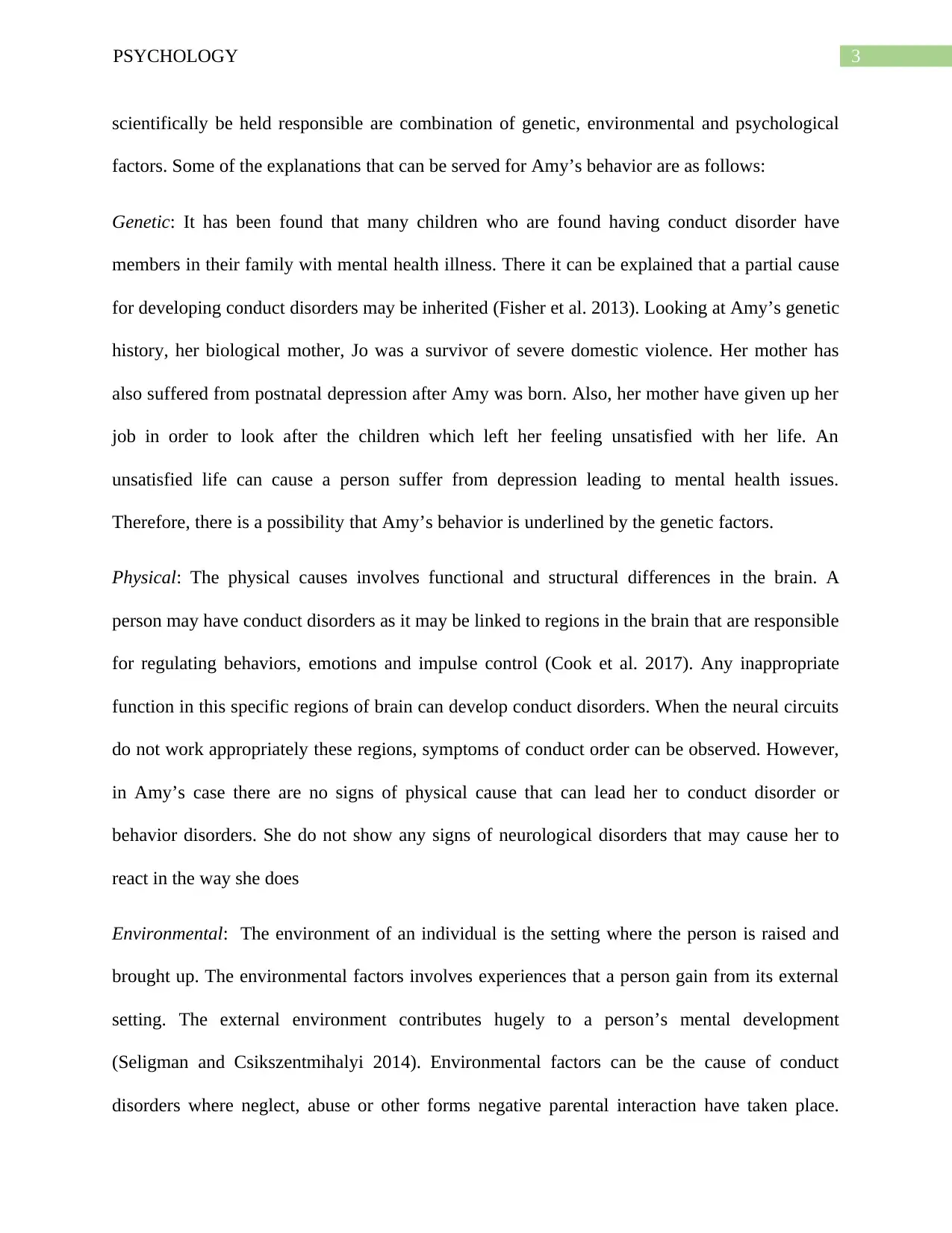
3PSYCHOLOGY
scientifically be held responsible are combination of genetic, environmental and psychological
factors. Some of the explanations that can be served for Amy’s behavior are as follows:
Genetic: It has been found that many children who are found having conduct disorder have
members in their family with mental health illness. There it can be explained that a partial cause
for developing conduct disorders may be inherited (Fisher et al. 2013). Looking at Amy’s genetic
history, her biological mother, Jo was a survivor of severe domestic violence. Her mother has
also suffered from postnatal depression after Amy was born. Also, her mother have given up her
job in order to look after the children which left her feeling unsatisfied with her life. An
unsatisfied life can cause a person suffer from depression leading to mental health issues.
Therefore, there is a possibility that Amy’s behavior is underlined by the genetic factors.
Physical: The physical causes involves functional and structural differences in the brain. A
person may have conduct disorders as it may be linked to regions in the brain that are responsible
for regulating behaviors, emotions and impulse control (Cook et al. 2017). Any inappropriate
function in this specific regions of brain can develop conduct disorders. When the neural circuits
do not work appropriately these regions, symptoms of conduct order can be observed. However,
in Amy’s case there are no signs of physical cause that can lead her to conduct disorder or
behavior disorders. She do not show any signs of neurological disorders that may cause her to
react in the way she does
Environmental: The environment of an individual is the setting where the person is raised and
brought up. The environmental factors involves experiences that a person gain from its external
setting. The external environment contributes hugely to a person’s mental development
(Seligman and Csikszentmihalyi 2014). Environmental factors can be the cause of conduct
disorders where neglect, abuse or other forms negative parental interaction have taken place.
scientifically be held responsible are combination of genetic, environmental and psychological
factors. Some of the explanations that can be served for Amy’s behavior are as follows:
Genetic: It has been found that many children who are found having conduct disorder have
members in their family with mental health illness. There it can be explained that a partial cause
for developing conduct disorders may be inherited (Fisher et al. 2013). Looking at Amy’s genetic
history, her biological mother, Jo was a survivor of severe domestic violence. Her mother has
also suffered from postnatal depression after Amy was born. Also, her mother have given up her
job in order to look after the children which left her feeling unsatisfied with her life. An
unsatisfied life can cause a person suffer from depression leading to mental health issues.
Therefore, there is a possibility that Amy’s behavior is underlined by the genetic factors.
Physical: The physical causes involves functional and structural differences in the brain. A
person may have conduct disorders as it may be linked to regions in the brain that are responsible
for regulating behaviors, emotions and impulse control (Cook et al. 2017). Any inappropriate
function in this specific regions of brain can develop conduct disorders. When the neural circuits
do not work appropriately these regions, symptoms of conduct order can be observed. However,
in Amy’s case there are no signs of physical cause that can lead her to conduct disorder or
behavior disorders. She do not show any signs of neurological disorders that may cause her to
react in the way she does
Environmental: The environment of an individual is the setting where the person is raised and
brought up. The environmental factors involves experiences that a person gain from its external
setting. The external environment contributes hugely to a person’s mental development
(Seligman and Csikszentmihalyi 2014). Environmental factors can be the cause of conduct
disorders where neglect, abuse or other forms negative parental interaction have taken place.
Paraphrase This Document
Need a fresh take? Get an instant paraphrase of this document with our AI Paraphraser
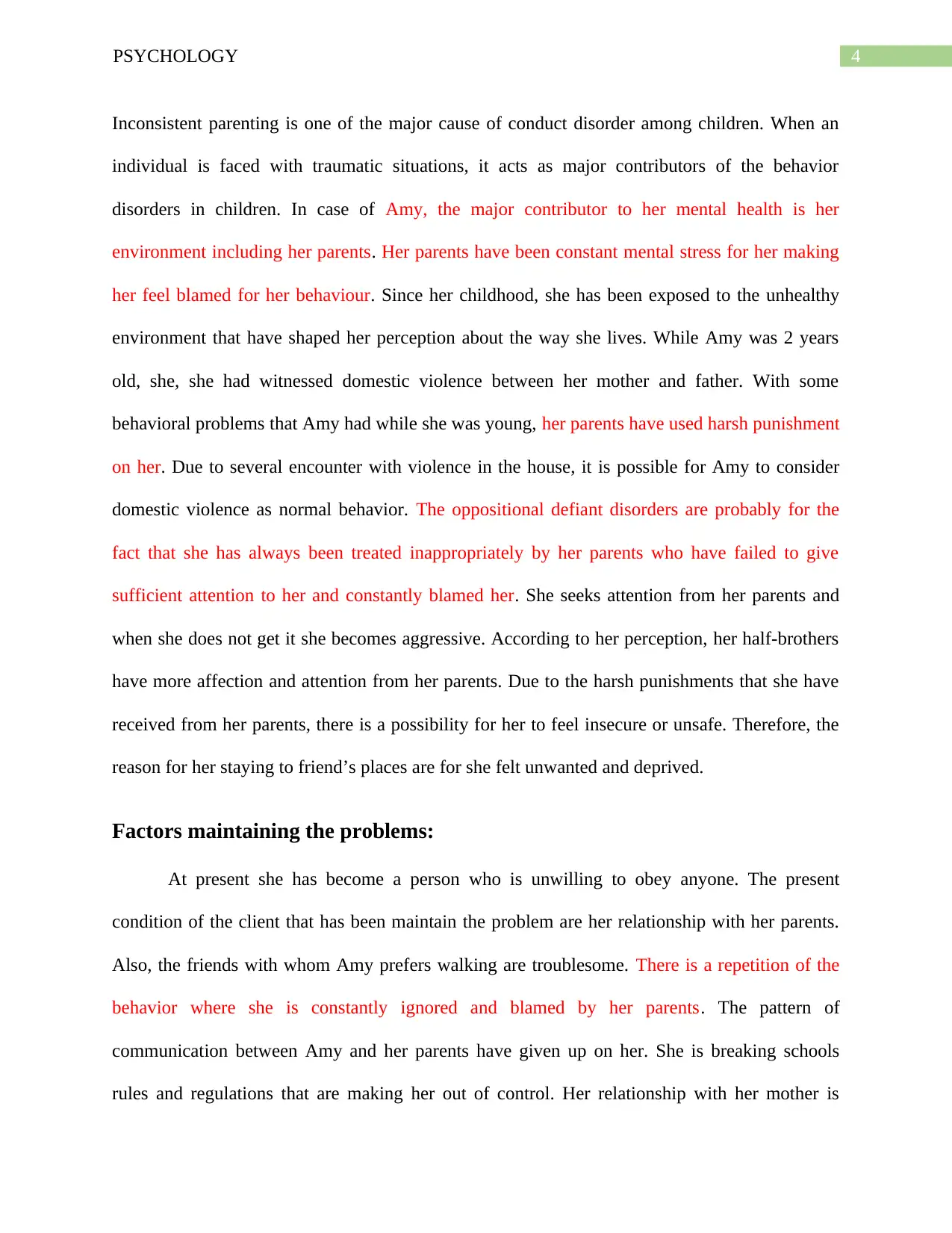
4PSYCHOLOGY
Inconsistent parenting is one of the major cause of conduct disorder among children. When an
individual is faced with traumatic situations, it acts as major contributors of the behavior
disorders in children. In case of Amy, the major contributor to her mental health is her
environment including her parents. Her parents have been constant mental stress for her making
her feel blamed for her behaviour. Since her childhood, she has been exposed to the unhealthy
environment that have shaped her perception about the way she lives. While Amy was 2 years
old, she, she had witnessed domestic violence between her mother and father. With some
behavioral problems that Amy had while she was young, her parents have used harsh punishment
on her. Due to several encounter with violence in the house, it is possible for Amy to consider
domestic violence as normal behavior. The oppositional defiant disorders are probably for the
fact that she has always been treated inappropriately by her parents who have failed to give
sufficient attention to her and constantly blamed her. She seeks attention from her parents and
when she does not get it she becomes aggressive. According to her perception, her half-brothers
have more affection and attention from her parents. Due to the harsh punishments that she have
received from her parents, there is a possibility for her to feel insecure or unsafe. Therefore, the
reason for her staying to friend’s places are for she felt unwanted and deprived.
Factors maintaining the problems:
At present she has become a person who is unwilling to obey anyone. The present
condition of the client that has been maintain the problem are her relationship with her parents.
Also, the friends with whom Amy prefers walking are troublesome. There is a repetition of the
behavior where she is constantly ignored and blamed by her parents. The pattern of
communication between Amy and her parents have given up on her. She is breaking schools
rules and regulations that are making her out of control. Her relationship with her mother is
Inconsistent parenting is one of the major cause of conduct disorder among children. When an
individual is faced with traumatic situations, it acts as major contributors of the behavior
disorders in children. In case of Amy, the major contributor to her mental health is her
environment including her parents. Her parents have been constant mental stress for her making
her feel blamed for her behaviour. Since her childhood, she has been exposed to the unhealthy
environment that have shaped her perception about the way she lives. While Amy was 2 years
old, she, she had witnessed domestic violence between her mother and father. With some
behavioral problems that Amy had while she was young, her parents have used harsh punishment
on her. Due to several encounter with violence in the house, it is possible for Amy to consider
domestic violence as normal behavior. The oppositional defiant disorders are probably for the
fact that she has always been treated inappropriately by her parents who have failed to give
sufficient attention to her and constantly blamed her. She seeks attention from her parents and
when she does not get it she becomes aggressive. According to her perception, her half-brothers
have more affection and attention from her parents. Due to the harsh punishments that she have
received from her parents, there is a possibility for her to feel insecure or unsafe. Therefore, the
reason for her staying to friend’s places are for she felt unwanted and deprived.
Factors maintaining the problems:
At present she has become a person who is unwilling to obey anyone. The present
condition of the client that has been maintain the problem are her relationship with her parents.
Also, the friends with whom Amy prefers walking are troublesome. There is a repetition of the
behavior where she is constantly ignored and blamed by her parents. The pattern of
communication between Amy and her parents have given up on her. She is breaking schools
rules and regulations that are making her out of control. Her relationship with her mother is

5PSYCHOLOGY
aggressive as well as her father. Although there are some people with whom she stays often, it
cannot be said they are the people who would help her understand the situation.
Factors that might facilitate change
When a person is observed with the disorders that have been mentioned above, it is
important to seek mental health help. Several treatments are possible, however the treatments
needs to be accepted by the client (Dicks 2014). Early treatment is necessary in cases such as
Amy’s. Cognitive therapy, behavioral therapy and combination of both, cognitive-behavioral
therapy. The therapy may include short-term and long-term intervention. While the long-term
interventions will prevent Amy’s behavior problems from worsening over time, the short-term
interventions will address the behavior problems that are currently identified having extremely
negative.
Behavior and cognitive therapy: Behavior patterns are in large part learned from rewards and
consequences, through this method actions with bad consequences can be unlearned and replace
the action with a more appropriate pro-social behavior. The encouragement of pro-social
behaviors is done by systematic manipulation of rewards as well as consequences promoting pro-
social behavior and discouraging anti-social behavior (Harvey et al. 2014). Behavior strategies
can be used to reduce the blame by parents along with increasing parental monitoring and
supervision. An appropriate behavior contract needs to be done considering parents of Amy with
explicit behavior details. Spelling out disrespectful behavior is can also be used that will
accompany the appropriate behavior. In addition, Amy will require constant therapy in order to
help Amy understand the ways to become more effective and fair disciplines. Cognitive behavior
therapy would help Amy develop several important cognitive skills (Tovote et al. 2014). This
would help her understand the situations in more peaceful way cognitively. Anger management
aggressive as well as her father. Although there are some people with whom she stays often, it
cannot be said they are the people who would help her understand the situation.
Factors that might facilitate change
When a person is observed with the disorders that have been mentioned above, it is
important to seek mental health help. Several treatments are possible, however the treatments
needs to be accepted by the client (Dicks 2014). Early treatment is necessary in cases such as
Amy’s. Cognitive therapy, behavioral therapy and combination of both, cognitive-behavioral
therapy. The therapy may include short-term and long-term intervention. While the long-term
interventions will prevent Amy’s behavior problems from worsening over time, the short-term
interventions will address the behavior problems that are currently identified having extremely
negative.
Behavior and cognitive therapy: Behavior patterns are in large part learned from rewards and
consequences, through this method actions with bad consequences can be unlearned and replace
the action with a more appropriate pro-social behavior. The encouragement of pro-social
behaviors is done by systematic manipulation of rewards as well as consequences promoting pro-
social behavior and discouraging anti-social behavior (Harvey et al. 2014). Behavior strategies
can be used to reduce the blame by parents along with increasing parental monitoring and
supervision. An appropriate behavior contract needs to be done considering parents of Amy with
explicit behavior details. Spelling out disrespectful behavior is can also be used that will
accompany the appropriate behavior. In addition, Amy will require constant therapy in order to
help Amy understand the ways to become more effective and fair disciplines. Cognitive behavior
therapy would help Amy develop several important cognitive skills (Tovote et al. 2014). This
would help her understand the situations in more peaceful way cognitively. Anger management
⊘ This is a preview!⊘
Do you want full access?
Subscribe today to unlock all pages.

Trusted by 1+ million students worldwide

6PSYCHOLOGY
training would be beneficial for Amy that would involve teaching the ways of managing anger
and frustration. Amy would learn to recognize anger sensations with relaxation and reframing
techniques such as deep breathing and muscle relaxation. Encouraging Amy talk about her
problem will help her identifying the issues and acknowledging it.
The time frame of the therapy may vary four months to one year depending on Amy. The
severity of the issue is high in Amy’s case as her behavior issues have developed from the
environment she has been exposed since childhood. Therefore, the time frame of the treatment
can be considered four months to one year. In the end of the therapy, Amy would be able to have
appropriate behavior along with anger management.
Amy can be advised to maintain a thought diary which will be used to record examples of
negative thinking and challenges that she face. This may involve the challenges that Amy come
across while having the sessions or the challenges she faces in her house with her parents as well.
The reason she frequently disappears from home can be listed in the thought diary which will
give clear idea of what make her leave home.
Recommendations for systemic interventions
In the book mad or bad: a critical approach to counselling and forensic psychology, a
reflective team discussion is mention. This involves discussing the perception of the client in
front of the client’s family (Vossler et al. 2017.). It is an innovative method that in family
counselling. The method involves a team of professional careers who reflect on specific issues of
family. Along with Amy, there is a requirement of family counselling. Amy’s mental illness is
associated with her family environment which needs immediate amendments. Therefore,
including Amy’s parents will help finding different ways for the therapist to recommend the best
training would be beneficial for Amy that would involve teaching the ways of managing anger
and frustration. Amy would learn to recognize anger sensations with relaxation and reframing
techniques such as deep breathing and muscle relaxation. Encouraging Amy talk about her
problem will help her identifying the issues and acknowledging it.
The time frame of the therapy may vary four months to one year depending on Amy. The
severity of the issue is high in Amy’s case as her behavior issues have developed from the
environment she has been exposed since childhood. Therefore, the time frame of the treatment
can be considered four months to one year. In the end of the therapy, Amy would be able to have
appropriate behavior along with anger management.
Amy can be advised to maintain a thought diary which will be used to record examples of
negative thinking and challenges that she face. This may involve the challenges that Amy come
across while having the sessions or the challenges she faces in her house with her parents as well.
The reason she frequently disappears from home can be listed in the thought diary which will
give clear idea of what make her leave home.
Recommendations for systemic interventions
In the book mad or bad: a critical approach to counselling and forensic psychology, a
reflective team discussion is mention. This involves discussing the perception of the client in
front of the client’s family (Vossler et al. 2017.). It is an innovative method that in family
counselling. The method involves a team of professional careers who reflect on specific issues of
family. Along with Amy, there is a requirement of family counselling. Amy’s mental illness is
associated with her family environment which needs immediate amendments. Therefore,
including Amy’s parents will help finding different ways for the therapist to recommend the best
Paraphrase This Document
Need a fresh take? Get an instant paraphrase of this document with our AI Paraphraser
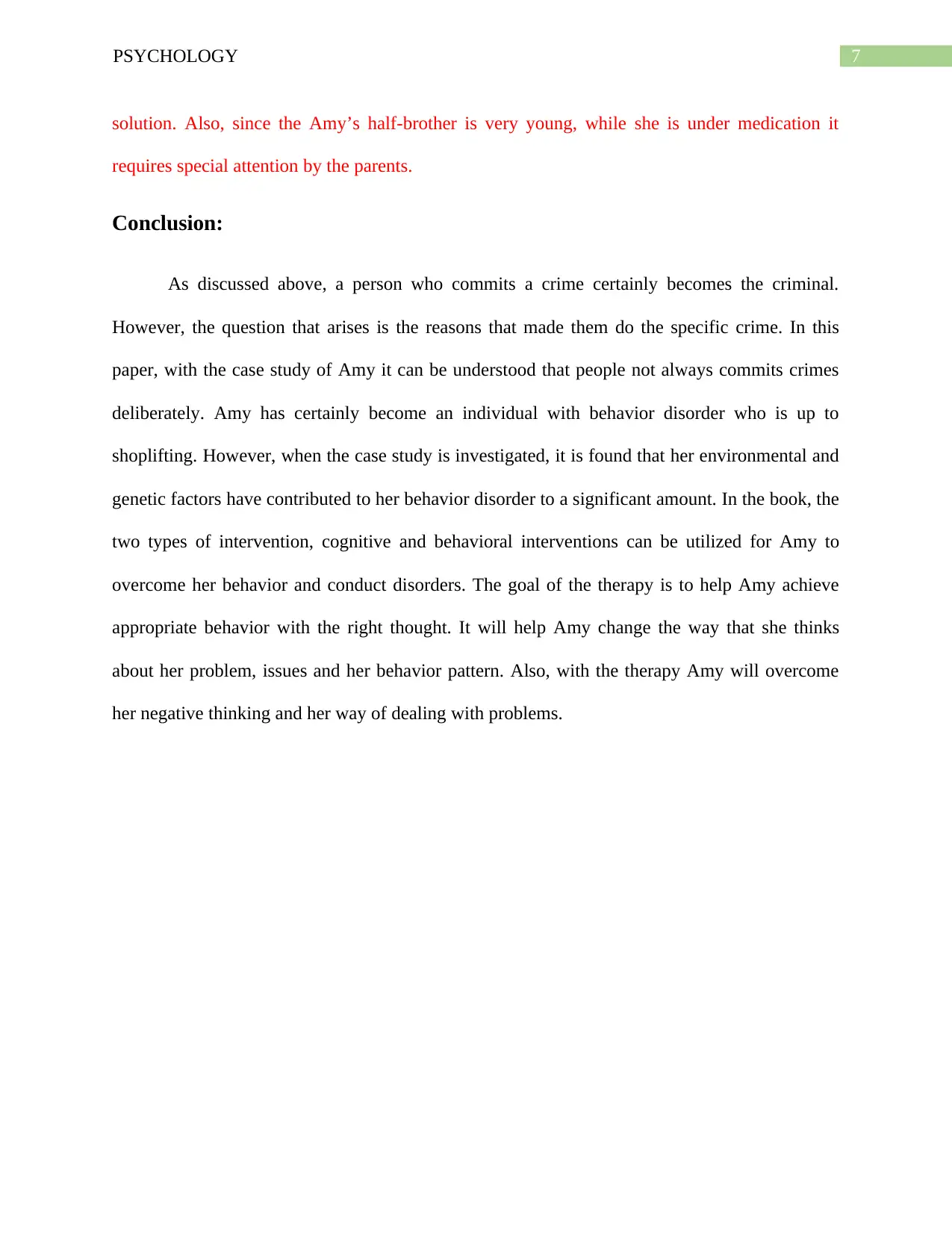
7PSYCHOLOGY
solution. Also, since the Amy’s half-brother is very young, while she is under medication it
requires special attention by the parents.
Conclusion:
As discussed above, a person who commits a crime certainly becomes the criminal.
However, the question that arises is the reasons that made them do the specific crime. In this
paper, with the case study of Amy it can be understood that people not always commits crimes
deliberately. Amy has certainly become an individual with behavior disorder who is up to
shoplifting. However, when the case study is investigated, it is found that her environmental and
genetic factors have contributed to her behavior disorder to a significant amount. In the book, the
two types of intervention, cognitive and behavioral interventions can be utilized for Amy to
overcome her behavior and conduct disorders. The goal of the therapy is to help Amy achieve
appropriate behavior with the right thought. It will help Amy change the way that she thinks
about her problem, issues and her behavior pattern. Also, with the therapy Amy will overcome
her negative thinking and her way of dealing with problems.
solution. Also, since the Amy’s half-brother is very young, while she is under medication it
requires special attention by the parents.
Conclusion:
As discussed above, a person who commits a crime certainly becomes the criminal.
However, the question that arises is the reasons that made them do the specific crime. In this
paper, with the case study of Amy it can be understood that people not always commits crimes
deliberately. Amy has certainly become an individual with behavior disorder who is up to
shoplifting. However, when the case study is investigated, it is found that her environmental and
genetic factors have contributed to her behavior disorder to a significant amount. In the book, the
two types of intervention, cognitive and behavioral interventions can be utilized for Amy to
overcome her behavior and conduct disorders. The goal of the therapy is to help Amy achieve
appropriate behavior with the right thought. It will help Amy change the way that she thinks
about her problem, issues and her behavior pattern. Also, with the therapy Amy will overcome
her negative thinking and her way of dealing with problems.
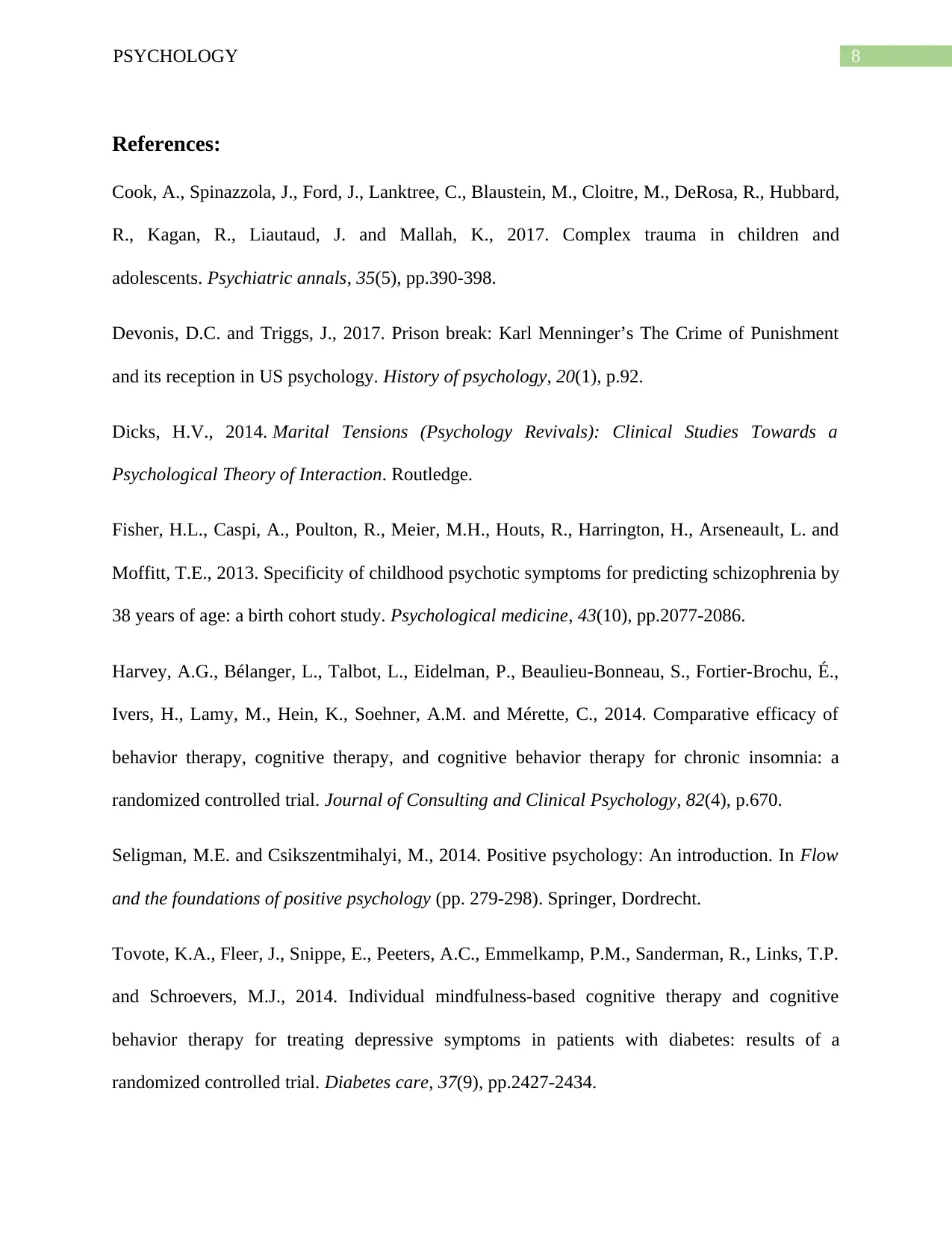
8PSYCHOLOGY
References:
Cook, A., Spinazzola, J., Ford, J., Lanktree, C., Blaustein, M., Cloitre, M., DeRosa, R., Hubbard,
R., Kagan, R., Liautaud, J. and Mallah, K., 2017. Complex trauma in children and
adolescents. Psychiatric annals, 35(5), pp.390-398.
Devonis, D.C. and Triggs, J., 2017. Prison break: Karl Menninger’s The Crime of Punishment
and its reception in US psychology. History of psychology, 20(1), p.92.
Dicks, H.V., 2014. Marital Tensions (Psychology Revivals): Clinical Studies Towards a
Psychological Theory of Interaction. Routledge.
Fisher, H.L., Caspi, A., Poulton, R., Meier, M.H., Houts, R., Harrington, H., Arseneault, L. and
Moffitt, T.E., 2013. Specificity of childhood psychotic symptoms for predicting schizophrenia by
38 years of age: a birth cohort study. Psychological medicine, 43(10), pp.2077-2086.
Harvey, A.G., Bélanger, L., Talbot, L., Eidelman, P., Beaulieu-Bonneau, S., Fortier-Brochu, É.,
Ivers, H., Lamy, M., Hein, K., Soehner, A.M. and Mérette, C., 2014. Comparative efficacy of
behavior therapy, cognitive therapy, and cognitive behavior therapy for chronic insomnia: a
randomized controlled trial. Journal of Consulting and Clinical Psychology, 82(4), p.670.
Seligman, M.E. and Csikszentmihalyi, M., 2014. Positive psychology: An introduction. In Flow
and the foundations of positive psychology (pp. 279-298). Springer, Dordrecht.
Tovote, K.A., Fleer, J., Snippe, E., Peeters, A.C., Emmelkamp, P.M., Sanderman, R., Links, T.P.
and Schroevers, M.J., 2014. Individual mindfulness-based cognitive therapy and cognitive
behavior therapy for treating depressive symptoms in patients with diabetes: results of a
randomized controlled trial. Diabetes care, 37(9), pp.2427-2434.
References:
Cook, A., Spinazzola, J., Ford, J., Lanktree, C., Blaustein, M., Cloitre, M., DeRosa, R., Hubbard,
R., Kagan, R., Liautaud, J. and Mallah, K., 2017. Complex trauma in children and
adolescents. Psychiatric annals, 35(5), pp.390-398.
Devonis, D.C. and Triggs, J., 2017. Prison break: Karl Menninger’s The Crime of Punishment
and its reception in US psychology. History of psychology, 20(1), p.92.
Dicks, H.V., 2014. Marital Tensions (Psychology Revivals): Clinical Studies Towards a
Psychological Theory of Interaction. Routledge.
Fisher, H.L., Caspi, A., Poulton, R., Meier, M.H., Houts, R., Harrington, H., Arseneault, L. and
Moffitt, T.E., 2013. Specificity of childhood psychotic symptoms for predicting schizophrenia by
38 years of age: a birth cohort study. Psychological medicine, 43(10), pp.2077-2086.
Harvey, A.G., Bélanger, L., Talbot, L., Eidelman, P., Beaulieu-Bonneau, S., Fortier-Brochu, É.,
Ivers, H., Lamy, M., Hein, K., Soehner, A.M. and Mérette, C., 2014. Comparative efficacy of
behavior therapy, cognitive therapy, and cognitive behavior therapy for chronic insomnia: a
randomized controlled trial. Journal of Consulting and Clinical Psychology, 82(4), p.670.
Seligman, M.E. and Csikszentmihalyi, M., 2014. Positive psychology: An introduction. In Flow
and the foundations of positive psychology (pp. 279-298). Springer, Dordrecht.
Tovote, K.A., Fleer, J., Snippe, E., Peeters, A.C., Emmelkamp, P.M., Sanderman, R., Links, T.P.
and Schroevers, M.J., 2014. Individual mindfulness-based cognitive therapy and cognitive
behavior therapy for treating depressive symptoms in patients with diabetes: results of a
randomized controlled trial. Diabetes care, 37(9), pp.2427-2434.
⊘ This is a preview!⊘
Do you want full access?
Subscribe today to unlock all pages.

Trusted by 1+ million students worldwide

9PSYCHOLOGY
Vossler, A., Havard, C., Pike, G., Barker, M.J. and Raabe, B. eds., 2017. Mad Or Bad?: A
Critical Approach to Counselling and Forensic Psychology. Sage.
Vossler, A., Havard, C., Pike, G., Barker, M.J. and Raabe, B. eds., 2017. Mad Or Bad?: A
Critical Approach to Counselling and Forensic Psychology. Sage.
1 out of 10
Related Documents
Your All-in-One AI-Powered Toolkit for Academic Success.
+13062052269
info@desklib.com
Available 24*7 on WhatsApp / Email
![[object Object]](/_next/static/media/star-bottom.7253800d.svg)
Unlock your academic potential
Copyright © 2020–2025 A2Z Services. All Rights Reserved. Developed and managed by ZUCOL.





